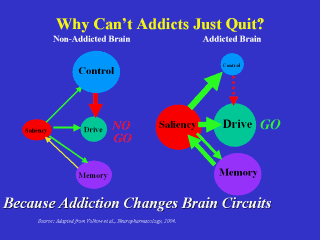Search inside of Supercourse and lectures in HTML and PPT format
 |
 |
front |1 |2 |3 |4 |5 |6 |7 |8 |9 |10 |11 |12 |13 |14 |15 |16 |17 |18 |19 |20 |21 |22 |23 |24 |25 |26 |27 |28 |29 |30 |31 |32 |33 |34 |35 |36 |37 |38 |39 |40 |review |
 Addiction changes brain circuitry, making it hard to “apply the brakes” to detrimental behaviors. In the non-addicted brain, control mechanisms constantly assess the value of stimuli and the appropriateness of the planned response, applying inhibitory control as needed. In the addicted brain, this control circuit becomes impaired through drug abuse, losing much of its inhibitory power over the circuits that drive response to stimuli deemed salient. |
|